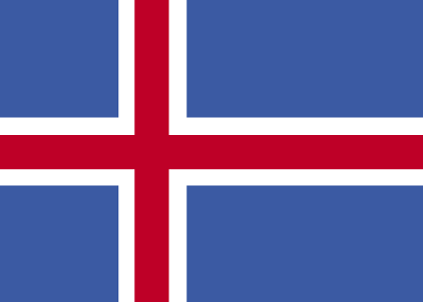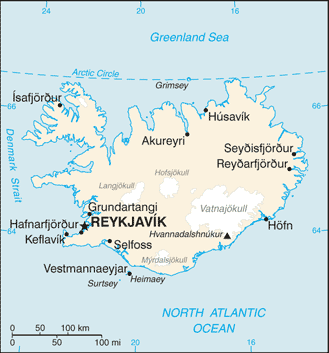
|
|
Advertisements:
EconomyEconomy - overview
Iceland's Scandinavian-type social-market economy combines a capitalist structure and free-market principles with an extensive welfare system. Prior to the 2008 crisis, Iceland had achieved high growth, low unemployment, and a remarkably even distribution of income. The economy depends heavily on the fishing industry, which provides 40% of export earnings, more than 12% of GDP, and employs 7% of the work force. It remains sensitive to declining fish stocks as well as to fluctuations in world prices for its main exports: fish and fish products, aluminum, and ferrosilicon. Iceland's economy has been diversifying into manufacturing and service industries in the last decade, particularly within the fields of software production, biotechnology, and tourism. Abundant geothermal and hydropower sources have attracted substantial foreign investment in the aluminum sector, boosted economic growth, and sparked some interest from high-tech firms looking to establish data centers using cheap green energy, although the financial crisis has put several investment projects on hold. Much of Iceland's economic growth in recent years came as the result of a boom in domestic demand following the rapid expansion of the country's financial sector. Domestic banks expanded aggressively in foreign markets, and consumers and businesses borrowed heavily in foreign currencies, following the privatization of the banking sector in the early 2000s. Worsening global financial conditions throughout 2008 resulted in a sharp depreciation of the krona vis-a-vis other major currencies. The foreign exposure of Icelandic banks, whose loans and other assets totaled more than 10 times the country's GDP, became unsustainable. Iceland's three largest banks collapsed in late 2008. The country secured over $10 billion in loans from the IMF and other countries to stabilize its currency and financial sector, and to back government guarantees for foreign deposits in Icelandic banks. GDP fell 6.8% in 2009, and unemployment peaked at 9.4% in February 2009. GDP rose 2.4% in 2011 and unemployment declined to 6.0%. Since the collapse of Iceland's financial sector, government economic priorities have included: stabilizing the krona, implementing capital controls, reducing Iceland's high budget deficit, containing inflation, addressing high household debt, restructuring the financial sector, and diversifying the economy. Three new banks were established to take over the domestic assets of the collapsed banks. Two of them have foreign majority ownership, while the State holds a majority of the shares of the third. Iceland began making payments to the UK, the Netherlands, and other claimants in late 2011 following Iceland's Supreme Court ruling that upheld 2008 emergency legislation that gives priority to depositors for compensation from failed Icelandic banks. Iceland owes British and Dutch authorities approximately $5.5 billion for compensating British and Dutch citizens who lost deposits in Icesave when parent bank Landsbanki failed in 2008. Iceland began accession negotiations with the EU in July 2010; however, public support has dropped substantially because of concern about losing control over fishing resources and in reaction to worries over the ongoing Eurozone crisis. Gdp (purchasing power parity) World Ranking: 146
$12.57 billion (2011 est.)
$12.2 billion (2010 est.) $12.71 billion (2009 est.) Note Data are in 2011 US dollars Gdp (official exchange rate)
$14.05 billion (2011 est.)
Gdp - real growth rate World Ranking: 117
3.1% (2011 est.)
-4% (2010 est.) -6.8% (2009 est.) Gdp - per capita (ppp) World Ranking: 24
$38,500 (2011 est.)
$37,800 (2010 est.) $39,800 (2009 est.) Note Data are in 2011 US dollars Gdp - composition by sector
Agriculture 5.4%
Industry 24.7% Services 69.9% (2011 est.) Labor force World Ranking: 174
175,700 (2011 est.)
Labor force - by occupation
Agriculture 4.8%
Industry 22.2% Services 73% (2008) Unemployment rate World Ranking: 84
7.4% (2011 est.)
8.1% (2010 est.) Population below poverty line
NA%
Note 332,100 families (2011 est.) Household income or consumption by percentage share
Lowest 10% NA%
Highest 10% NA% Distribution of family income - gini index World Ranking: 121
28 (2006)
25 (2005) Investment (gross fixed) World Ranking: 138
14.1% of GDP (2011 est.)
Budget
Revenues $5.861 billion
Expenditures $6.477 billion (2011 est.) Taxes and other revenues World Ranking: 42
41.7% of GDP (2011 est.)
Budget surplus (+) or deficit (-) World Ranking: 145
-4.4% of GDP (2011 est.)
Public debt World Ranking: 6
128.3% of GDP (2011 est.)
125.2% of GDP (2010 est.) Inflation rate (consumer prices) World Ranking: 101
4% (2011 est.)
5.4% (2010 est.) Central bank discount rate World Ranking: 64
5.4% (31 January 2012 est.)
5.75% (31 December 2010 est.) Commercial bank prime lending rate World Ranking: 93
7.7% (31 December 2011 est.)
10.242% (31 December 2010 est.) Stock of narrow money World Ranking: 107
$4.123 billion (31 December 2011 est.) $4.31 billion (31 December 2010 est.) Stock of broad money World Ranking: 96
$12.57 billion (31 December 2010 est.) $8.032 billion (31 December 2010 est.) Stock of domestic credit World Ranking: 62
$67.57 billion (31 December 2011 est.) $69.71 billion (31 December 2010 est.) Market value of publicly traded shares World Ranking: 98
$2.021 billion (31 December 2011) $1.996 billion (31 December 2010) $1.128 billion (31 December 2009) Agriculture - products
Potatoes, green vegetables; mutton, chicken, pork, beef, dairy products; fish Industries
Fish processing; aluminum smelting, ferrosilicon production; geothermal power, hydropower, tourism Industrial production growth rate World Ranking: 101
3% (2011 est.)
Electricity - production World Ranking: 76
16.48 billion kWh (2009 est.)
Electricity - consumption World Ranking: 75
16.48 billion kWh (2009 est.)
Electricity - exports
0 kWh (2009 est.)
Electricity - imports
0 kWh (2009 est.)
Oil - production World Ranking: 184
0 bbl/day (2010 est.)
Oil - consumption World Ranking: 132
17,430 bbl/day (2010 est.)
Oil - exports World Ranking: 114
1,209 bbl/day (2009 est.)
Oil - imports World Ranking: 127
15,530 bbl/day (2009 est.)
Oil - proved reserves World Ranking: 144
0 bbl (1 January 2011 est.)
Natural gas - production World Ranking: 195
0 cu m (2010 est.)
Natural gas - consumption World Ranking: 189
0 cu m (2010 est.)
Natural gas - exports World Ranking: 115
0 cu m (2010 est.)
Natural gas - imports World Ranking: 205
0 cu m (2010 est.)
Natural gas - proved reserves World Ranking: 189
0 cu m (1 January 2011 est.)
Current account balance World Ranking: 122
-$1 billion (2011 est.)
-$1.009 billion (2010 est.) Exports World Ranking: 116
$5.3 billion (2011 est.)
$4.603 billion (2010 est.) Exports - commodities
Fish and fish products 40%, aluminum, animal products, ferrosilicon, diatomite Exports - partners
Netherlands 32.5%, Germany 15.1%, UK 9%, Norway 4.4% (2011) Imports World Ranking: 132
$4.501 billion (2011 est.)
$3.621 billion (2010 est.) Imports - commodities
Machinery and equipment, petroleum products, foodstuffs, textiles Imports - partners
Norway 16%, US 10.9%, Germany 7.9%, Netherlands 7.4%, China 6.3%, Denmark 6.2%, Brazil 5.8%, UK 5.2% (2011) Reserves of foreign exchange and gold World Ranking: 78
$8.55 billion (31 December 2011 est.) $5.79 billion (31 December 2010 est.) Debt - external World Ranking: 39
$124.5 billion (30 June 2011)
$3.073 billion (2002 est.) Stock of direct foreign investment - at home
$NA (31 December 2011)
$9.2 billion (31 December 2008) Stock of direct foreign investment - abroad
$NA (31 December 2011)
$8.8 billion (31 December 2008) Exchange rates
Icelandic kronur (ISK) per US dollar - 115.95 (2011 est.)122.24 (2010 est.) 123.64 (2009) 85.619 (2008) 63.391 (2007) Fiscal year
Calendar year
Comments
Add a new comment: |
Advertisement
Members area
Iceland (Reykjavik):
 
GPS points from Iceland (Reykjavik)
|
||||||||

 Settled by Norwegian and Celtic (Scottish and Irish) immigrants during the late 9th and 10th centuries A.D., Iceland boasts the world's oldest functioning legislative assembly, the Althing, established in 930. Independent for over 300 years, Iceland was subsequently ruled by Norway and Denmark. Fallout from the Askja volcano of 1875 devastated the Icelandic economy and caused widespread famine. Over the next quarter century, 20% of the island's population emigrated, mostly to Canada and the US. Denmark granted limited home rule in 1874 and complete independence in 1944. The second half of the 20th century saw substantial economic growth driven primarily by the fishing industry. The economy diversified greatly after the country joined the European Economic Area in 1994, but Iceland was especially hard hit by the global financial crisis in the years following 2008. Literacy, longevity, and social cohesion are first rate by world standards.
Settled by Norwegian and Celtic (Scottish and Irish) immigrants during the late 9th and 10th centuries A.D., Iceland boasts the world's oldest functioning legislative assembly, the Althing, established in 930. Independent for over 300 years, Iceland was subsequently ruled by Norway and Denmark. Fallout from the Askja volcano of 1875 devastated the Icelandic economy and caused widespread famine. Over the next quarter century, 20% of the island's population emigrated, mostly to Canada and the US. Denmark granted limited home rule in 1874 and complete independence in 1944. The second half of the 20th century saw substantial economic growth driven primarily by the fishing industry. The economy diversified greatly after the country joined the European Economic Area in 1994, but Iceland was especially hard hit by the global financial crisis in the years following 2008. Literacy, longevity, and social cohesion are first rate by world standards.